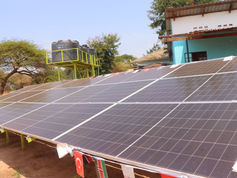Pride in the Energy Sector: Why Inclusion Matters in the Energy Transition
- Wadee Deeprawat

- Jun 27
- 4 min read
June marks Pride Month, a time to reflect on equality, not just in society, but also in how we build our future. Asia's clean energy revolution is underway, but who gets to participate? For women and LGBTQ+ individuals, barriers to green jobs and leadership still persist, especially in male-dominated renewable energy sectors.
Across Asia, investment in renewable energy, from solar and wind to hydropower and regional grid projects, is expanding rapidly. Yet, women remain underrepresented in STEM fields and in decision-making positions. Only 16% of countries in Asia report an equal or above-equal proportion of women working in STEM-related fields, compared to 30% of the global STEM research workforce. LGBTQ+ representation is even less visible, rarely acknowledged in industry data or policy discussions.
Barriers to gender equity in the energy sector stem from broader cultural norms and financial constraints. Many Asian women face obstacles to pursuing STEM education and entering technical fields. Long hours, male-dominated environments, and family responsibilities limit their participation. Poor working conditions and limited job availability also discourage inclusion. Trans and non-binary individuals often struggle with legal identity recognition, restricting access to formal employment, reflecting a need for more analysis and studies on marginalized groups in the energy sector. To address this gap, the IEA Gender Diversity Initiative is also making efforts to strengthen data collection and analysis, ensuring that workplace gender diversity is realized in the energy sector.
Globally, women account for 32% of the renewable energy workforce, while in ASEAN, the figure drops to 8%, with women earning about 15% less than their male counterparts. Data on LGBTQ+ workers in Asia is limited, but on a global scale, 40% of global energy companies now report active efforts to promote diversity in hiring.
In Asia, a talent shortage in renewable energy is prompting companies to recruit a more diverse pool of candidates. India launched its first LGBTQ+ Chamber of Commerce in 2019, signaling growing support for inclusive workforces, even if not specifically in the energy sector. While this is not energy-specific, it signals increasing support for inclusive workforces. In Thailand, multicultural energy firms like PTTEP, Petronas, and Pertamina publicly report gender and ethnicity, and LGBTQ+ inclusion occurs informally, particularly in Thailand's more open culture. However, LGBTQ+ communities face harsher legal challenges and social acceptance in other Asian countries, hindering formal data collection and reporting on LGBTQ+ inclusion in the workforce.
Some organizations are already leading the way. The United Nations Economic and Social Commission for Asia and the Pacific (UNESCAP) is actively working to promote gender equality in the clean energy transition across the region. ESCAP is preparing a working paper for the Clean Energy Ministerial meeting in Busan, Korea, in August 2025. The paper outlines key barriers and provides policy recommendations, as well as case studies, that demonstrate how inclusive energy systems can unlock social and economic benefits.
On the ground, ESCAP is implementing two clean cooking projects, engaging women in transitioning from traditional to modern electric cooking methods, including solar-powered cooking, in countries such as Bhutan and Lao PDR. ESCAP also hosts platforms for policymakers to exchange knowledge on integrating gender into just energy transition strategies.
"Women must be seen not only as beneficiaries of energy access, but as agents of change who can lead innovation, governance, and climate action," says Kimberly Roseberry, Economic Affairs Officer at ESCAP’s Energy Division.
The Deutsche Gesellschaft für Internationale Zusammenarbeit (GIZ)'s Just Energy Transition project, under the CASE (Clean, Affordable, and Secure Energy for Southeast Asia) program, is also working to integrate gender and social inclusion into national and local energy transition strategies, particularly in coal-affected regions. A key priority is to institutionalize gender-transformative approaches through capacity-building, inclusive stakeholder engagement, and the development of gender-responsive policies. This includes setting clear targets, such as 30% representation of women and marginalized groups in decision-making, and using disaggregated data to inform strategies.
"We seek to ensure the representation of women and LGBTQ+ groups in leadership and decision-making roles in shaping an equitable energy future that leaves no one behind,” says Warisa Sihirunwong, Project Advisor, CASE, GIZ Thailand.
The World Bank's Women’s Employment in Renewable Energy Report also highlights the need for leadership commitment, access to STEM education, and workplace policies that support women's retention and career advancement. Similarly, a joint guideline by UNEP and UN Women also provides a step-by-step guide on how to integrate gender in energy policies.
Still, this is just the beginning. Inclusion in the energy sector means more than simply hiring more women and LGBTQ+ workers. It requires systemic change: inclusive, non-discriminatory work environments where underrepresented groups rise to decision-making roles and shape the energy agenda. This means investing in training and leadership programs that prepare women and LGBTQ+ people for the clean tech future.
Breaking down structural barriers and expanding access to education are key to unlocking the full potential of diverse voices. Their insight and innovation are essential to achieving a just and sustainable energy transition. Gender-responsive energy planning is critical in Asia's green transition, and inclusion is central to achieving climate justice. As Pride Month comes to a close, let's push for an energy transition in Asia that not only decarbonizes but also democratizes. A truly green future must be both just and inclusive.













Comments